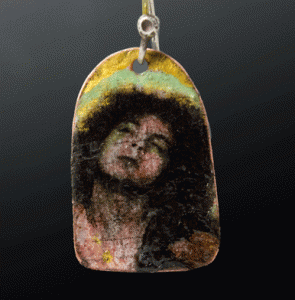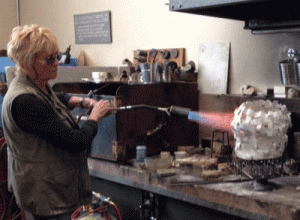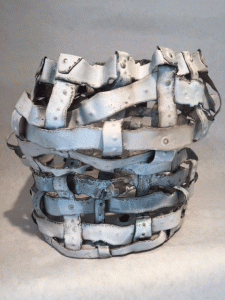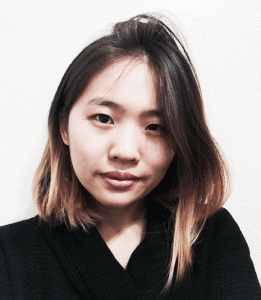With this post we continue our interviews with artists from the California Now exhibition at Richmond Art Center. Read the previous interview here.
Evelyn Markasky
Evelyn Markasky “became obsessed” with enameling after taking a two-week class with Deborah Lozier at Cabrillo College. Since then she has also taken a Radical Enameling Workshop with Andrew Kuebeck at the Richmond Art Center. She has worked with enamel for about ten years, and prizes its unpredictability.
How do you work with the media? Do you consider your techniques experimental?
I torch fire all my work, which I think automatically makes it experimental. Whenever someone tells you, “You should never do it this way,” my brain immediately can’t hear anything else and wants to see what will happen if I do that forbidden thing.

“St. Johnny of the Booth,” Evelyn Markasky, pierced copper with iron oxide pigments and torch-fired vitreous enamels in liquid form, and gold luster. From ‘Personal Icons’ series
Where do you find inspiration for your work, and what are you working on now?
Most of my inspiration comes from my Greek background and my love of pop art (Andy Warhol, Jean Michel-Basquiat, etc.) Right now I’m working on faces–cutting them out of metal, painting them with enamels.
Where do you show or sell your work?
Vessel Gallery, Oakland, CA; 1000 Oaks, Gallery, Berkeley, CA; Studio Seven Arts, Pleasanton, CA; Ornamental Metal Museum, Memphis, TN; Enamelist Society Exhibition 2015; Santa Cruz Open Studio Art Tour.
What advice would you give someone just starting out in this medium?
Don’t be afraid to experiment!
Duane Fitzgerald began enameling in 1975, incorporating cloisonné into the jewelry that she sold from her studio/shop in Del Mar, CA. When she began her jewelry design and manufacturing business in 1982, cloisonné was too time-consuming a process to include, and she only returned to enameling in 2001 after leaving her business.
Where and with whom did you study?
I learned the cloisonné techniques at UCSD studying under Carol Wilcox, and learned the techniques I now use by experimenting on my own. Originally I was attracted to the jewel-like appearance of the enameled pieces, but when I returned to enameling 19 years later I became intrigued by the endless possibilities of experimenting, especially on large pieces.
How do you work with the media? Do you consider your techniques experimental?
I fire with both the kiln and the torch, depending on both the size and the finish I am looking for, but I prefer experimenting with torch firing because I sometimes get unexpected results, which open up new possibilities. I am also experimenting with different ways of adding raku to the enameled pieces.
What role does enamel play in your creative process?
My work has two creative parts. First I create the copper base and then decide what enamel textures I would like to achieve. The enamel gives the piece color, texture and life, and since I love experimenting with the torch on the enamel, it is also the most fun.
In the four short years that Olivia Shih has worked with enamels, it has become part of the toolkit of materials that she uses to express herself through art. Her work can be found at Lireille in Oakland, California, various locations, or on her website: www.oliviashih.com.
What drew you to this medium?
Originally, I was tempted by the colors, but I stayed for the lack of control. With metal, I work with precise measurements and clean solder seams; with enamel, I’m forced to partially surrender control, which can be a little painful but ultimately worthwhile.
When I work with enamel, it’s less about the technique and more about articulating a specific emotion.
Where and with whom did you study?
I began my studies in Taiwan, where I would spend hours grinding enamel with pestle and mortar and washing impurities out with distilled water. At the California College of the Arts, I studied with Deborah Lozier, who taught me everything else—from torch firing to sifting to purposefully making mistakes. She would always say that if you can repeat a mistake consistently, it would no longer be a mistake, but a technique. I’ve also taken an enameling workshop from Andrew Kuebeck and learned about the possibilities of image-making on enameling.
How do you work with the media?
My techniques are rather simple but I don’t mind. When I work with enamel, it’s less about the technique and more about articulating a specific emotion.
What role does enamel play in your creative process?
For some of my pieces, the metal acts as scaffolding or armature, and the enamel provides the personality. I’ve played with creating the illusion of warmth and softness through the application of enamel.
Where do you find the inspiration for your work?
One of my professors, Nick Dong, once asked me, “What is your core?” It might sound ridiculous, but I really didn’t know the answer. Even now, my inability to answer frustrates me, so with each new piece, I work toward answering this question. Right now, I’m working my way through a number of alternative materials, including concrete epoxy, Plasti-Dip, powder coating, acrylic, and silicone.
What advice would you give someone just starting out in this medium?
Get ready to make mistakes.






I would like to subscribe to this blog!